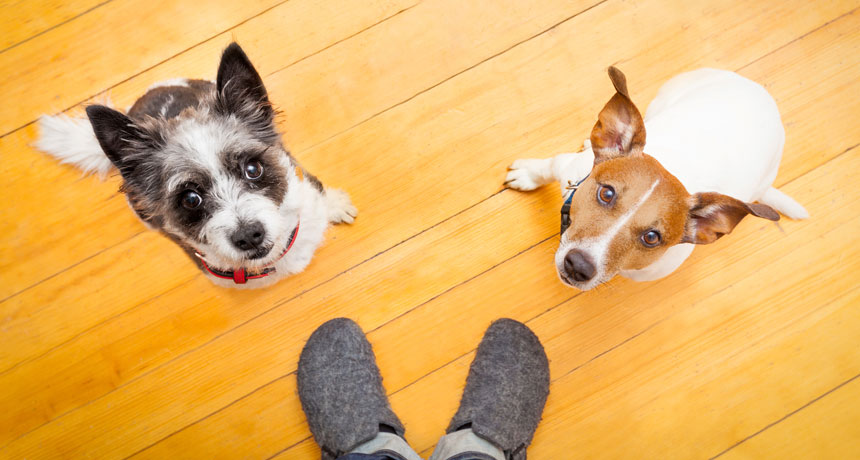Wolves beat dogs at problem-solving test
Facing a treat-filled puzzle, wolves proved less willing than dogs to give up

Dogs tend to focus on nearby humans and their expressions. And this may get in the way of solving practical problems, a new study hints.
damedeeso/istockphoto
By Susan Milius
Humans may be a bad influence on their best friends — at least when it comes to problem-solving. In a task that wasn’t very tough, wolves outperformed dogs. All any of the animals had to do was tug the lid off of a food container.
Monique Udell studies animal behavior at Oregon State University in Corvallis. In recent tests, canine were given a closed, plastic storage box containing a sausage treat. Eight of the 10 wolves successfully gnawed, pawed and ripped their way into the container — then gobbled up the treat. In contrast, just one in 20 dogs succeeded at the same challenge.
The social tendencies of dogs may be getting in the way of persistent, independent struggling that would have freed the treat, Udell now suggests.

Udell offered the same challenge to wolves. These animals had been raised and fed by people but still lived outdoors. Here, the wolves barely looked at a nearby person. Instead, they devoted about 90 percent of each two-minute trial to grappling with the box holding a treat.
When someone hovered over the dogs and actively encouraged them to keep trying to open the box, the dogs did spend more time tackling the problem. A few more even managed to open the box. But their success rate still did not match the wolves. The dogs and wolves also were tested when no one was present. But even now, the dogs didn’t paw or mouth the box much more than they did when a human was present.
Udell published her findings September 16 in Biology Letters.
Are people to blame?
Clive Wynne suggests that one way of looking at the results is that “wolves are practical problem solvers and dogs are social problem solvers.” Wynne studies dog behavior at Arizona State University in Tempe. He worked with Udell on earlier dog research, although not on this project.
“We teach our dogs to be stupid,” Wynne suspects. Early and abundant exposure to human outrage at a sandwich stolen off a plate or a raided kitchen cabinet, may teach our pets to proceed cautiously in helping themselves, he says. In contrast, the wolves here had been raised by people but lived in an outdoor enclosure. So they are much less likely to have been scolded for eating people food or breaking into containers.
A tidbit of preliminary data in the paper suggests dogs don’t start out so inept at opening containers. Udell reported on an 8-week-old puppy that managed to open the box. Youthful pets may have less training in the etiquette of sharing human homes. If they do better than adult dogs at ripping open food boxes, that might suggest living that living with people taught them to be cautious.
Udell’s test grew out of an urge to reverse an experimental scenario. It comes from a line of experiments going back to a 2003 paper. It had been published by Ádám Miklósi of Eötvös Loránd University in Budapest, Hungary, and his colleagues. Back then, there had been a surge of interest in how dogs differ from wolves. So the researchers trained nine dogs and nine human-raised wolves to open a box and snag a treat. When presented with a box that couldn’t be opened as expected — because its lid was glued on — dogs were more likely than wolves to turn their gaze toward a human face.
In Udell’s tests, dogs tended to give up and to turn big dog eyes on a person as if perhaps waiting for human help. (Or waiting for some sign that it was OK to chew into the box.)
“Dogs were selected to some extent for being able to cooperate with humans,” he says. And this deep history helps explain dog sensitivity to human social cues. That sensitivity encourages people to tolerate canine company. “Otherwise,” he says, “we would just live with wolves.”
Power Words
(for more about Power Words, click here)
canid The biological family of mammals that are carnivores and omnivores. The family includes dogs, wolves, foxes, jackals and coyotes. Members of this family are known as canines.
domestic animal A tame animal that commonly lives with people, such as a dog, cat or horse.
domestication A process of producing a tame version of an animal from a wild one, which can take thousands of years.
etiquette Formal or expected conventions — essentially manners — about what is appropriate behavior in given social settings. It can deal with which types of silverware to use with certain foods, how and when to address people and how to demonstrate proper respect for others.
scenario An imagined situation of how events or conditions might play out.







